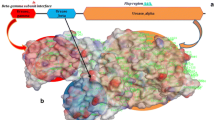Abstract
Catalase (CAT) is one of the most active enzyme catalysts found in plants, animals and in all aerobic microorganisms. The major function of the enzyme is to decompose H2O2, produced by cellular metabolic activities under normal and stressful conditions to water and oxygen. The present study involves 3D structure modeling of wheat catalase from Triticum aestivum by MODELLER9v7 and its binding study with H2O2. The Evaluation of the model was based on Discrete Optimized Protein Energy Score (DOPE). The structure was also validated using PROCHECK comprising of 95.0% amino acid residues in favored regions of Ramachandran plot, Verify3D and ProsA which confirm that the model is reliable. The 3D model of the molecule was found to consist of ten strands and seventeen helices having a common fold characterised by β-pleated sheet flanked either side by helices. The docking study with H2O2 indicates that Gln352 and Arg353 are two important determinant residues in binding H2O2 as these residues have strong hydrogen bonding contacts with the substrate. These hydrogen-bonding interactions play a significant role in the stability of the complex.
Similar content being viewed by others
References
Altshul, S.F., Madden T.L., Schaffer, A.A., Zhang, J., Zhang, W., Mille, W., Lipman, D. 1997. Gapped Blast and PSIBLAST: A new generation of protein data base search programs. J Nucl Acids Res 25, 3389–3402.
Bowie, J.U., Luthy, R., Eisenberg, D. 1991. A method to identify protein sequences that fold into a known three-dimensional structure. Science 253, 164–170.
Guex, N., Peitsch, M.C. 1997. SWISS-MODEL and the Swiss-PdbViewer: An environment for comparative protein modeling. Electrophoresis 18, 2714–2723.
Hall, T.A. 1999. BioEdit: A user-friendly biological sequence alignment editor and analysis program for Windows 95/98/NT. Nucl Acids Symp Ser 41, 95–98.
Hara, I., Ichise, N., Kojima, K., Kondo, H., Ohgiya, S., Matsuyama, H., Yumoto, I. 2007. Relationship between the size of the bottleneck 15 A from iron in the main channel and the reactivity of catalase corresponding to the molecular size of substrates. Biochemistry 46, 11–22.
Iwamoto, M., Higo, H., Higo, K. 2000. Differential diurnal expression of rice catalase genes: the 5′ flanking region of CatA is not sufficient for circadian control. Plant Sci 151, 39–46.
John, B., Sali, A. 2003. Comparative protein structure modeling by iterative alignment, model building and model assessment. Nucl Acid Res 31, 3982–3992.
Laskowski, R.A., MacArthur, M.W., Moss, D.S., Thornton, J.M. 1993. PROCHECK a program to check the stereo chemical quality of protein structure. J Appl Cryst 26, 283–291.
Laskowski, R.A., Watson, J.D., Thornton, J.M. 2005. ProFunc: A server for predicting protein function from 3D structure. Nucl Acid Res W89–93.
Laurie, A.T., Jackson, R.M. 2005. Q-SiteFinder: An energy-based method for the prediction of proteinligand binding sites. Bioinformatics, 21, 1908–1916.
Luthy, R., Bowie, J.U., Eisenberg, D. 1992. Assessment of protein models with three-dimensional profiles. Nature 356, 83–85.
Mahmoud, H., Taoufik, B., Youssef, H., Abdel, A.M., Patrick, J. 2009. Insight into the role of catalases in salt stress in potato (Solanum tuberosum L). Biotechnol Agron Soc Environ 13, 373–379.
Mizuguchi, K., Deane, C.M., Blundell, T.L., Johnson, M.S., Overington, J.P. 1998. JOY: Protein sequencestructure representation and analysis. Bioinformatics 14, 617–623.
Mulder, N., Apweiler, R. 2007. InterPro and Inter-ProScan: Tools for protein sequence classification and comparison. Methods Mol Biol 396, 59–70.
Sali, A., Blundell, T.L. 1993. Comparative protein modelling by satisfaction of spatial restraints. J Mol Biol 234, 779–815.
Sekhar, P.N., Polavarapu, B., Kavi, K., Reddy, L.A., Mondal, P., Dash, A.K., Kar, M., Mohanty, S., Sabat, S.C. 2006. In silico modeling and hydrogen peroxide binding study of rice catalase. In Silico Biol 6, 0041.
Shen, M.Y., Sali, A. 2006. Statistical potential for assessment and prediction of protein structures. Protein Sci 15, 2507–2524.
Sippl, M.J. 1993. Recognition of errors in three-dimensional structures of proteins. Proteins 17, 355–362.
Tsuyoshi, M., Kenji, N., Shamsul, H.P., Kimiko, N., Toshiyuki, S., Yujiro, Y. 2010. Production of salt stress tolerant rice by over expression of the catalase gene, katE, derived from Escherichia coli. As Pac J Mol Biol Biotechnol 18, 37–41.
Vetrano, A.M., Heck, D.E., Mariano, T.M., Mishin, V., Laskin, D.L., Laskin, J.D. 2005. Characterization of the oxidase activity in mammalian catalase. J Biol Chem 280, 35372–35381.
Author information
Authors and Affiliations
Corresponding author
Rights and permissions
About this article
Cite this article
Sahu, G.K., Sahoo, B.B., Bhandari, S. et al. In silico 3D structure prediction and hydrogen peroxide binding study of wheat catalase. Interdiscip Sci Comput Life Sci 5, 77–83 (2013). https://doi.org/10.1007/s12539-013-0154-0
Received:
Revised:
Accepted:
Published:
Issue Date:
DOI: https://doi.org/10.1007/s12539-013-0154-0




